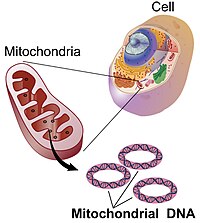
Photo from wikipedia
An increasing number of studies have related the mitochondrial DNA (mtDNA) content to embryo viability and transfer outcomes. However, previous studies have focused more on the relationship between mtDNA and… Click to show full abstract
An increasing number of studies have related the mitochondrial DNA (mtDNA) content to embryo viability and transfer outcomes. However, previous studies have focused more on the relationship between mtDNA and embryo implantation, few studies have studied the effect of the mtDNA content on live birth. In the study, we investigated whether mtDNA content is a reliable screening biomarker for live birth after single blastocyst transfer. A total of 233 couples with 316 blastocyst stage embryos undergoing in vitro fertilization treatment and pre-implantation genetic testing analysis were included in the study. All embryos were chromosomally normal and had undergone single-embryo transfers. There was no significant difference observed in the blastocyst mtDNA content among the live birth, miscarriage and non-implanted groups (p=0.999), and the mtDNA content in blastocysts from the miscarriage and live birth groups was similar [median (interquartile range), 1.00*108(7.59*107- 1.39*108) vs 1.01*108 (7.37*107- 1.32*108)]. Similarly, no significant association was observed between mtDNA content and embryo implantation potential (p=0.965). After adjusting for multiple confounders in a logistic regression analysis with generalized estimating equations, no associations between mtDNA content and live birth were observed in all blastocysts, Day-5 and Day-6 blastocysts (p=0.567, p=0.673, p=0.165, respectively). The live birth rate was not significantly different between blastocysts with an elevated mtDNA content and blastocysts with a normal mtDNA content (26.7% vs 33.6% p=0.780). Additionally, there was no linear correlation between the mtDNA content and maternal age (p=0.570). In conclusion, the mtDNA content does not seem to be a potential biomarker for embryo transfer outcomes (i.e., implantation and live birth) based on the existing testing tools. Embryos with an elevated mtDNA content also have development potential for successful live birth.
Journal Title: Frontiers in Endocrinology
Year Published: 2021
Link to full text (if available)
Share on Social Media: Sign Up to like & get
recommendations!